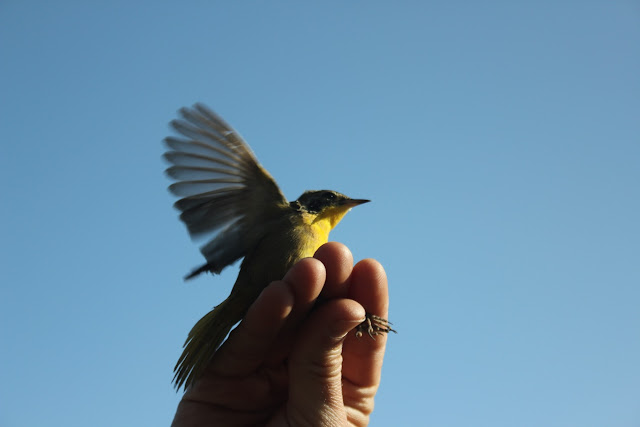Today Cory, Dan Lipp, Mark Dettling and I banded at one of PRBO's offsites, called Pine Gulch. It consists of 10 net lanes in riparian and marsh-edge habitat alongside Bolinas Lagoon. I really love this spot, not only because we usually catch a lot of birds, but also because we can scope the lagoon for waterfowl, shorebirds and raptors in between net runs. Birds we've seen from our banding location include, but are not limited to,
Eurasian Wigeon, Long-billed Curlew, Marbled Godwit, hundreds of
American Wigeon and
Northern Pintail, Peregrine Falcon, Bald Eagle, Clark's Grebe, six species of gulls,
Marsh Wren, Savannah Sparrow, and
Orange-crowned Warbler.
Today was an especially good day because we got to see many of these birds, and we also captured 44 birds in our nets. This time of year can be extremely slow, but Pine Gulch was as busy as ever this morning with 17 recaptures and 27 new birds accounting for 15 species! Our totals included 6
Golden-crowned Sparrow, 8
Song Sparrow, 2
Hermit Thrush, 1
Townsend's Warbler, 1
Orange-crowned Warbler, 1
Chestnut-backed Chickadee, 1
Downy Woodpecker, 6
Ruby-crowned Kinglet, 7
Dark-eyed "Oregon" Junco, 1
Lincoln's Sparrow, 1
Common Yellowthroat, 1
Swamp Sparrow, 1
Bewick's Wren, 4
Purple Finch, and 3
Fox Sparrow.
 |
| Swamp Sparrows are fairly uncommon in Marin county, only showing up on roughly 3% of all ebird checklists in the first week of December, and peaking at 3.5% in the second week. This individual is an after hatching year bird based on the amount of rufous color in the crown and gray in the supercillium (eyebrow). [Photo by Dan Lipp] |
|
|
|
|
|
|
 |
| Townsend's Warbler is not an unusual bird in winter in California, but this striking after hatching year male was a treat to band. The amount of black on the throat, white on the median coverts, and relatively broad and truncate rectrices (tail feathers) indicated that this bird is an adult male. [Photo by Dan Lipp] |
 |
| Common Yellowthroats are not terribly common in winter in Marin county, but they remain in decent numbers in suitable habitat like Pine Gulch. This bird was aged as a hatching year bird based on its relatively narrow and tapered rectrices and plumage, and sexed as a male based on the presence of a dark mask. [Photo by Dan Lipp] |
 |
| Taking the length of the wing chord is a good measure of the approximate size of the bird. Here I am taking the wing chord measurement. [Photo by Dan Lipp] |
 |
| One of the four Purple Finches we caught today had a strange growth on the left foot, perhaps tumorous or some strange form of bird pox, which is a common avian disease (but definitely does not normally look like this). We weren't really sure what was causing this malformation, but we welcome your comments and thoughts. [Photo by Dan Lipp] |
 |
| One note that we take for Golden-crowned Sparrows involves looking at the extent of the chocolate/black stripes and yellow on the crown. Very short stripes or very long stripes can help decipher the ages of the birds, but in between birds can remain ambiguous. This bird has relatively short crown stripes becoming indistinct past the lores (area just behind the bill), and was called a hatching year. [Photo by Dan Lipp] |
 |
| Another helpful way to age birds is to look at their rectrices. In general, younger birds have narrow, tapered tail feathers that are relatively abraded, and older birds have broad, truncate feathers. This Golden-crowned Sparrow's rectrices match those of typical HY birds. [Photo by Dan Lipp] |
 |
| Another good measure of relative size is weight. Since birds can fly, we cannot simply place them on a scale and hope they sit around long enough to get an accurate measure. Instead we use cylinders of various sizes to place the birds in, and keep them from escaping. It does not hurt the bird, and lasts only a few seconds. [Photo by Dan Lipp] |
|
|
By Luke Musher









No comments:
Post a Comment